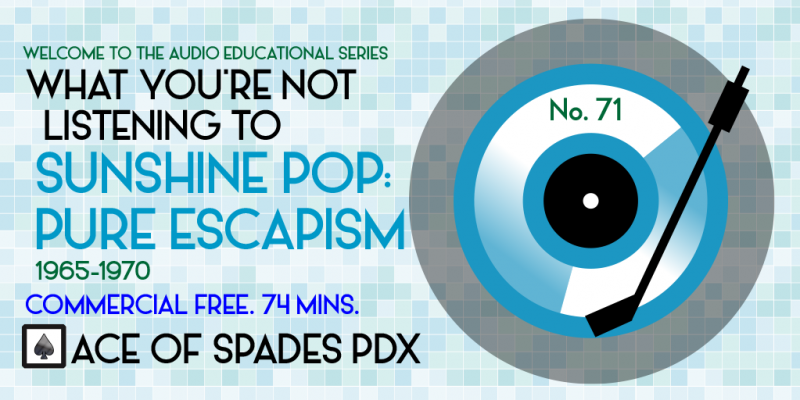Podcast: Play in new window | Download | Embed
Popular music can be used as a vehicle to reflect the politics of the day. More often, though, it is used an escape, and a means to remember the beauty of the world. #popmusic #sunshinepop #AMRadioGold #COVID19
Children of the revolution, this is a story about love, life, loss, hope and most importantly, family.
Recently, I asked myself the same question I have always asked: does this program/design/video/etc. matter?
Then you get the letter, at least I did, from an older lesbian couple in my old stomping grounds of the South Bay in Los Angeles. Two wonderful women, Lillian and Judith, were going through some very real and very saddening times, dropped me an e-mail. In subsequent phone conversations, I found out that both were previously married to men, have a total of seven children and twelve grandchildren, with a thirteenth one on the way.

They needed something to cheer them up. Since the COVID-19 pandemic, where Los Angeles has been hit incredibly hard, they have been missing their kids and grandkids something awful. And then the most devastating news: Lillian’s former husband passed away from the disease two weeks ago.
“What makes you believe that I can help,” I asked.
“We know you’re the guy. We found the tribute to your mother on the internet,” Judith said.
Needless to say, I was taken aback and simultaneously humbled.
“We got one of those Alexa things…it played Eve of Destruction.”
Lillian, who requested this program
Lillian then told me the following: “We got one of those Alexa things, or whatever it’s called. I asked it to play me something from the 60’s. It played Eve of Destruction.”
“I haaaaate that song. So much for technology,” I replied.
We all lamented the lack of music from the 50’s, 60’s and 70’s on the airwaves, which are now considered “too old” for Oldies Stations. They wanted me to program a show that specifically dealt with what has been commonly marketed as AM Gold, pop music from latter part of the 1960’s. They were both born in the early 1950’s; this music blasted from their transistor radios and reminded them both of happier times when the world was full of sunny days, promise and love. They also wished to have a virtual meet up with the rest of their family; play music, dance, and ultimately, grieve and celebrate. That is, they told me, if they can get the Alexa thing, or whatever it’s called, to work.

For those not in the know, what they have specifically asked for is a term that has only come into use in the last several years to describe this kind of music: Sunshine Pop. Borrowing heavily from the Beach Boys and the sound and imagery that band practically invented, it was directed toward a specific audience: young women, especially tweens.
Primarily a producer-driven micro-genre, it nonetheless continued the fantasy of the Southern California dream through the end of the decade. It’s sister microgenres are Baroque Pop and Bubblegum Pop, and all are music forms that have enjoyed a major resurgence in the Indie Rock community.

Simple, catchy, fun, short songs with group harmonies are all hallmarks of this type of music. It stood in stark contrast to the political turmoil of the day, on purpose. For those of you who have seen the Pure Moods series of CD’s advertised, this one could easily be called Pure Escapism, because that is exactly what it is all about. Common lyrical themes are love, magic, the magic of love, flowers, clouds, sunshine…you get the picture.
Interestingly, not all of the songs are upbeat ditties, in spite of their ridiculously hooky, bright, sing along choruses. With some of them, there are hints of sadness, nostalgia, loss and melancholy: teen angst in a bright, shiny package. Just like life, it can’t be all happy times.
Or as Momma once said: “No rain, no rainbows.”
First Part
- Do You Believe In Magic, 1965, The Lovin’ Spoonful
- I Found Love, 1968, The Free Design
- Don’t Sleep In The Subway, 1967, Petula Clark
- Sit Down, I Think I Love You, 1967, The Mojo Men
- Daydream Believer, 1967, The Monkees
- Yellow Balloon, 1967, Yellow Balloon
- Along Comes Mary, 1966, The Association
- The Rain, The Park and Other Things, 1967, The Cowsills
- You Got To Be Loved, 1967, The Montanas
- Crystal Blue Persuasion (album version), 1969, Tommy James and The Shondells
Second Part
- Up, Up And Away, 1967, The 5th Dimension
- My World Fell Down, 1967, Sagittarius
- Eleanor, 1968, The Turtles
- Good Morning Starshine, 1969, Oliver
- I Saw Her Again Last Night, 1966, The Mamas and The Papas
- Tighter, Tighter, 1970, Alive ‘N Kickin’
- 98.6, 1966, Keith
- Love (Can Make You Happy), 1969, Mercy
- Morning Girl, 1969, The Neon Philharmonic
Finale
- Sunday Will Never Be The Same, 1967, Spanky and Our Gang
Love to you all.
Ben “Daddy Ben Bear” Brown Jr.
Host, Producer, Webmaster, Audio Engineer, Researcher and Writer
“Copyright Disclaimer Under Section 107 of the Copyright Act 1976, allowance is made for ‘fair use’ for purposes such as criticism, comment, news reporting, teaching, scholarship, and research. Fair use is a use permitted by copyright statute that might otherwise be infringing. Non-profit, educational or personal use tips the balance in favor of fair use.”
